Bryan David Falchuk's Blog: Do a Day Blog, page 6
June 17, 2016
Tell Whole Foods Not to Sell Veal
 For those who shop at Whole Foods Markets (WFM), you might be familiar with the animal welfare ratings that they have on various meats in the butcher section which were created by the Global Animal Partnership. For those who don’t shop there are haven’t noticed the signage, they are a way of helping the consumer understand the conditions in which the animal lived before it became meat for purchase (ok, that’s a nice way of saying, “before it got slaughtered, butchered and packaged.”). The ratings go from 1 (worst) to 5+ (best). 1 is the least stringent, and is stated as ‘No cages, no crates, no crowding.” And Whole Foods goes a step further by saying it will not sell meat that can’t at least be rated as a 1. Well, at least for species for which they apply the step-rating scale. Cows are one species for which the scale applies (this becomes relevant and important in a moment).
For those who shop at Whole Foods Markets (WFM), you might be familiar with the animal welfare ratings that they have on various meats in the butcher section which were created by the Global Animal Partnership. For those who don’t shop there are haven’t noticed the signage, they are a way of helping the consumer understand the conditions in which the animal lived before it became meat for purchase (ok, that’s a nice way of saying, “before it got slaughtered, butchered and packaged.”). The ratings go from 1 (worst) to 5+ (best). 1 is the least stringent, and is stated as ‘No cages, no crates, no crowding.” And Whole Foods goes a step further by saying it will not sell meat that can’t at least be rated as a 1. Well, at least for species for which they apply the step-rating scale. Cows are one species for which the scale applies (this becomes relevant and important in a moment).Now, I’m a big fan of Whole Foods, and do much of my family’s grocery shopping at the chain. We eat organic and try to support businesses that have the same feelings toward organics, GMOs, local foods, etc. While there are certainly better markets (we have some great, small, local stores in our area), it’s good to have a supermarket that has much of what we choose to buy in a single location so I’m not hitting four or five little places to cover all of our needs (oddly enough, I often have to go to more than one Whole Foods to meet our needs, but I have four of them within 15 minutes of my home).
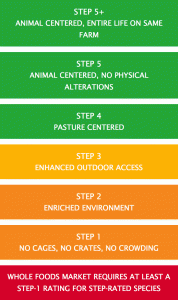
As a vegan, I also appreciate the chain as there is a lot of choice for me. Obviously the produce section has me well-covered, but they have tons of other vegan-friendly products in stock (sauces, tortillas, Clif Bar products, meat-alternatives and vegan burritos or pizzas, etc).
Putting together my dietary choice with WFM’s decision to label their meats to help consumers be more aware of how the animals they choose to eat have lived, I came across something really perplexing – veal. There are basically two meats that are about as cruel as you can get, and veal is one of them (the other is foie gras, which is goose liver that is made by force-feeding the goose so its liver becomes exceptionally fatty). If you don’t know how veal is ‘made’, I’ll share how with you, but a word of warning as it can be extremely upsetting, so please skip the rest of this paragraph if you want. This description comes from the Massachusetts Society for the Prevention of Cruelty to Animals (the state chapter os the ASPCA, which also runs the best veterinary hospital in the state, Angell Memorial):
Calves raised to make veal are severely confined. Veal calves commonly live for 18 to 20 weeks in wooden crates with chains around their neck. The chain is tethered to a crate which measures 6 feet long and 2 feet wide. The size of the crate restricts the movement of the calf to either lie down or stand; the calf can not turn around or stretch his/her limbs.
Calves raised to become veal are also purposely fed an all liquid milk substitute which is deficient in iron and fiber in order to produce anemia which results in the pale colored flesh typical of veal.
Veal calves are slaughtered at 16-20 weeks of age unable to walk to slaughter as their muscles are severely underdeveloped. Some veal calves are killed at just a few days old to be sold as low-grade ‘bob’ veal for products like frozen TV dinners.
While beef cattle may not have what the vegan in me feels is a great existence, clearly the life of a calf being raised for veal is much worse. It’s saddening at best, and maddening at worst. I chose long ago – long before choosing to be vegan – never to eat veal again. And many other meat-eaters have made the same conclusion after learning of how veal calves are raised.
At a very basic level, veal is – by definition – raised in a caged/crated environment. It’s a big one, but it’s still a confining structure, like a cage or crate. And it’s even referred to as a ‘box’. So, technically by its own standards, Whole Foods shouldn’t be selling veal. But they do.
With that as background, perhaps you see where I got perplexed. How is that a company that is making an effort to educate people on the conditions in which meat animals live would sell meat from an animal that is tortured? I’m not saying ‘torture’ in the way an animal activist would say factory farming is torture. I’m saying it in the literal sense of the word. No interpretation needed.
You could argue that there’s no conflict here. WFM isn’t taking a stand, they’re merely labeling. This fits with their push for broader labeling across the board, and specifically in the whole GMO labeling debate. On GMOs, they’re actually mandating that all products they sell be GMO-free (I believe by 2018), so maybe that shows a bit of the conflict. They don’t just like labeling and transparency, but do choose in some cases to come down on the side of a cause, belief or position. So why is it different with animal welfare? They care enough to tell people about the conditions the animals experience, and make a pretty big deal about it, especially when they have meat from a more human source (e.g. a free-range ranch).
While you could argue there may not be a conflict if WFM is just thinking of labeling as the end-game, I think there is a conflict. By labeling (and doing in-store promotion of those with better scores to reinforce the importance of the issue), they’re inherently drawing attention to more humane practices and almost ostracizing less humane sources of meat. It’s almost hypocritical to draw attention to the animal welfare issue while also selling veal (or foie gras).
 A calf being raised for veal
A calf being raised for vealBecause of this conflict, I would like to publicly ask Whole Foods Market to stop selling veal.
Think I’m crazy? Think it’s too extreme and all meat animals suffer, so why is this worse? It is worse simply due to the torture issue. The ends being the same doesn’t justify the means before the animal meets its end. And this isn’t such a crazy request. Outside of locations in Maine, WFM does not sell live lobster kept in a crowded tank. Why? Simple – they care about the animal’s welfare and feel that the tank life isn’t humane enough for their standards. They said it themselves in 2006 when they made the decision:
…we are not yet sufficiently satisfied that the process of selling live lobsters is in line with our commitment to humane treatment and quality of life for animals…
Hmm…so lobsters live in a crowded tank, and a tank is a large box. Yes, a box. That is, the same word that’s also used to describe the pen a veal calf lives in. Only here, the lobsters aren’t bumping up against the wall of the tank, keeping them from being able to move. I’m not saying they have it good, but they certainly don’t have it worse. And don’t forget that the lobsters lived freely before they were caught and put in a tank. That veal calf was penned from birth and taken from its mother. So if the lobster tank is a bridge too far for Whole Foods, I would suggest the process of raising veal is, too.
[tweet_box url=”http://newbodi.es/veal” design=”default”]Sign the #Petition! Tell @WholeFoods not to sell #veal. #DontEatVeal[/tweet_box]
If you’ve felt the same way about veal, or do now that you’ve read this, I’d like to ask you to join me. I’ve setup an online petition, and would ask you to add your voice to help effect change. I don’t call out Whole Foods Market because I don’t like them. I call them out for the opposite reason – I think they mean well and try to do what’s right. I think this is a chance to help them see that their current choices may not fall into that category, so a change is in order.

As John Mackey, co-CEO and founder of WFM says, people vote with their wallets, and they listen. Don’t choose to buy the things you don’t support. Don’t buy veal from Whole Foods (or elsewhere, for that matter), and that will help send the message. But let’s go a step further and actively vote by speaking up and seeing if we get heard.
You can sign the online petition here.
March 22, 2016
#5KEveryDay -> #5KAlmostEveryDay
For those who follow me on Twitter, Nike+, Strava and Garmin Connect, DailyMile and MapMyFitness, you’ll have seen that I was on streaking. No, not that kind of streaking. I was running at least 5K every day since just before New Years. I missed one day because I was sick, but quickly made it up, so I was giving myself a pass on that miss. However, I have now not run since this past Saturday – that’s three days and counting. Why? Well, when training for my first half marathon, I found that I have a split sesamoid bone in my left foot that is usually transparent to me, but gets symptomatic sometimes. And guess what – it’s symptomatic right now. I felt the pain building each day, but didn’t think that’s what it was (honestly, I actually just forgot about it, so it never occurred to me that this is what was going on). I had a choice – keep running and make things really bad, or take several days off, let everything cool down, and then start back carefully. I chose the second one.
Breaking my streak was upsetting, but I realized that I could either do it voluntarily and for a shorter amount of time, or I could be forced to do it and for a long time. And the thing is, I can always start back up and just streak from a later date. And that’s ok.
Why is it ok? It’s simple. The streak is something I’m doing for myself. To prove something to me. To do something for me. To stay strong and feel successful in my commitment to my own wellness. I’m not beholden to anyone else.
But there’s also the idea of quitting, and that giving an inch can lead to taking a mile. That’s I think where I get most unsettled. But that’s the old me. The old me would eat an Oreo, and then just eat another. But “just eat another” was a repeating phrase that would lead to an entire row in the package being devoured (if not the whole package). Taking a day off, sleeping in, etc – they can all lead to ‘just another’. But I’m not that person anymore. That fear is unfounded.
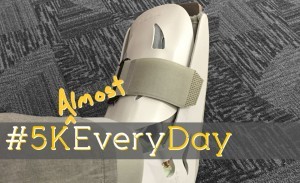 Yes, that’s my foot in that walking cast
Yes, that’s my foot in that walking castBut that fear can only be unfounded when we genuinely make it that way. I am staying committed to my fitness and my wellness. Right now, that doesn’t mean doing cardio as I normally do. Right now, that means making an active decision to let my foot get better, and seeing that in the light of being for my wellness. Just because you aren’t sweating, doesn’t mean you aren’t doing right by your body (that’s what eating right is all about, after all).
And I have woken up each morning and evaluated my situation to see if I can back get at it. So far, the smart decision is not to. And that will likely stay the smart decision a few days past when I feel like I could run. Otherwise, my next streak might just be a day long.
So this post is half for my own strength and resolve, and half to share the mental position injury or set backs can put you in no matter how strong or dedicated you are. And through sharing that, I hope people who have struggles see that no one is immune to them, and they don’t have to spell defeat or failure. Frame frame your decisions around them the right way, see how those decisions fuel your overall objectives, and get right back to winning.
Each successive win drives the next. Just broaden how you define winning to see that you are still doing great. That’s how, despite ‘set backs’, you keep at it and enlighten.your.body.
December 20, 2015
Booking It
So I’ve embarked on a really exciting and at the same time frighteningly large endeavor to write a book. I don’t want to give away too much, but wanted to at least put this out there (go public!).
The book will focus on the idea I wrote about in this blog post.
Stay tuned…more to follow.this blog post
October 13, 2015
Marathon Lookback
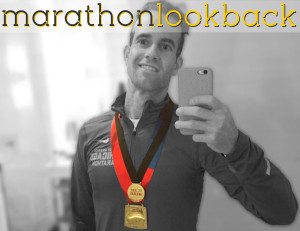 As I write this, I’m sitting on a plane, coming home from Chicago the day after running my first marathon in this amazing city. I wasn’t sure how long I’d need to take after the race to write this since my mind is kind of spent, but also because I need to process what just happened. I decided that there’s too much value in capturing my thoughts when they’re still fresh, so here I am.
As I write this, I’m sitting on a plane, coming home from Chicago the day after running my first marathon in this amazing city. I wasn’t sure how long I’d need to take after the race to write this since my mind is kind of spent, but also because I need to process what just happened. I decided that there’s too much value in capturing my thoughts when they’re still fresh, so here I am.
I ran the 2015 Chicago Marathon on behalf of St. Jude. Let me just take a moment to recognize this amazing organization. St. Jude is a children’s cancer institute that does research on treatments and cures for various forms of cancer that attack children, and also provides completely free treatment to children battling cancer. And they don’t stop there – they also provide counseling and support to the families of those kids along with free housing and food to families whose children are undergoing long-term treatment. St. Jude is an amazing place, and I was really honored and proud to run for them. I raised over $5,000, and the group of roughly 260 of us who are called “St. Jude Heroes” raised a record-breaking $455,000+ in this marathon. While the race is over, you can still donate at http://heroes.stjude.org/newbodies.
So leading up to the marathon, I trained for 170 days following a plan built just for me by a great running coach – Jason Fitzgerald at Strength Running. I had ups, and I had downs. I had injuries (though not from the running itself), and I records I would set every week, be they speed, mileage or a combination of the two. This was a huge commitment, and I’m proud of how I did the work to get there.
My goal was to break 4 hours, which means coming in just under 9 minutes for each mile. Based on my history and training, it would be tough, but achievable. As this was my first marathon, I was lucky to have the luxury of setting a personal record no matter how long it too me to finish (as long as I finished). I typically go into races with an aspirational goal and a back up goal, so my goals were 4 hours or finish. In reality, I wanted to be sure I finished in under 4:30 as my backup, but I never told anyone that. I finished in a time I’ll get to later in this piece, and got there with quite a bit of walking from miles 15 to 25. There were several moments between miles 17 and 23 when I wasn’t sure I’d finish at all. I did, however, finish, and did so by running (not walking any of) the final 1.2 miles really well – especially the final 800 meters, which I’m very proud of.
 Me on the course, feeling rough but pushing through
Me on the course, feeling rough but pushing throughI had an injury going into the race, but it wasn’t acute anymore, and stood little chance of impacting my race. The weather was set to be warmer than I had hoped for, but not too bad (60s-70s, though not humid). It was going to be windy – hey, it’s Chicago, what do you expect? – but the buildings do a good job of shielding you along the course. It was actually a stunning weekend – absolutely gorgeous and really pleasant if a touch too hot to be ideal for a marathon.
I went into the race at a time where there is a lot of very heavy stuff going on in my life around my job situation (I start a big new job the week after the marathon – not a life change I recommend around a marathon!). That created a lot of mental stress at a time when I really needed to be free of it. I came to peace with the situation before the race, and actually wasn’t thinking about it at all as I got closer to the race, and not at all while in Chicago. However, that stress lead to short sleep at night, with very early wakings. That is the root cause of my marathon not going as I had hoped. The two nights before the race, I slept really poorly. I got into bed early, but was fully awake by 1:30am and 12:30am, respectively. That made for a physical exhaustion that is just very hard to overcome no matter how much excitement or energy chews might be around you.
I started the race pretty well. One of the top rules of marathoning is not to go out too fast, and I did a pretty good job controlling my speed. I was fast, but still within the range I wanted to be in and felt pretty good through the first 3 miles. The next 3, I had planned to speed up slightly, and was just about where I wanted to be pace-wise. After the 10K mark, though, I was starting to feel tired, and of course I still had 20 miles to go!
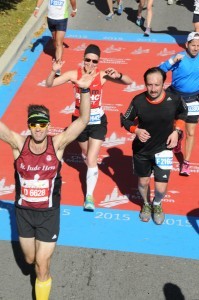 Trying to have a little fun with it to lift my spirits!.
Trying to have a little fun with it to lift my spirits!.I had been eating the energy chews I used throughout my training, as well as drinking an electrolyte-infused water I had used in training. Even though my legs were pretty fresh and I was fueled, I was fading. I tried to stay positive and motivated, and use all the tricks in the book – pick a landmark, run to it, then pick another; count steps; count breaths; count; sing a motivating song in your head; engage the crowd; etc. I did whatever I could to keep going.
The mile markers seemed to come so slowly, but I kept running. I ran through the 13.1 mile marker and timing mat, and wasn’t too far from my goal pace, so I used that to feel better mentally. I knew the crew from St. Jude would be around mile 14 with other charity groups, so I used that to get to that mileage. I had used up my first packet of energy chews by mile 14, so I decided to take 1 cup of Gatorade at the aide station. This is another one of the top rules of marathoning – do not do something on race day you’ve never done before, especially with fueling. I haven’t had Gatorade in literally over a decade. And I don’t eat or drink things that processed and fake. But I needed something, that was the only option, and I decided not to have a lot. The cup was half full (optimism!), and I only drank half of that. I swished the rest in my mouth and spat it out – a great trick as it signals to the brain that more fuel is coming, so it should stop holding back on the physical performance even if you don’t drink the stuff. Yeah, the brain can be fooled easily.
I felt the urge to pee, so I said I’d get to 15, and hit the porta-potties if there was no line, and used that to keep me going.
As I stopped at mile 15, I got right into a porta-potty, and came out with the decision to walk through the water tables that were right there. As I stepped onto the road, I was literally almost dropped to the ground with pain in my stomach. It was like I was being stabbed. I walked through it, but it kept coming in waves. I got some water, and walked until the waves died down.
I got running again after about .2 miles of walking. My ankles hurt a ton as I got back to running, but it faded within about 15 seconds of running.
 A dejected man walking part of the course, trying to avoid becoming a defeated man.
A dejected man walking part of the course, trying to avoid becoming a defeated man.This pattern repeated itself every mile – I’d try to run to the water tables, take some water and walk a bit, and get back to running with abdominal and ankle pain hitting hard as soon as I did. I would walk somewhere between a quarter and a half a mile typically. Once, I walked longer. My intense stomach pain faded as I stayed away from the Gatorade, but I also had some cramping from all the water I was drinking…yet I was also getting totally parched within about a minute of taking my last sip of water.
I was in pain, totally drained (try being exhausted, then dealing with a stabbing pain in your abdomen, and also knowing you have 10 miles to run still!), and starting to get worried about finishing. That wasn’t a question I had at all going into the race – I knew I’d finish even if it took 6 hours. But now I was facing enough of a tough situation that I might have to go into the medical tent and potentially stop the race.
What about all of my training? What about the kids at St. Jude who can’t just stop what they’re going through because they hurt, are tired or anything? What about all the friends and family who donated to my fundraising that were rooting for me and expecting me to finish? What about my goal and desire to feel such a profound achievement?
I let go of the 4:30 backup, but couldn’t latch on to the idea of ‘just finishing’ being good enough. I said 5 is my backup. And, honestly, that was going to be tough still. I just didn’t want to admit it to myself.
I kept at it. I met a guy who was in a similar place and we chatted. I’ve come to learn that he’s a minister, which probably explains why he was so helpful for me. He didn’t say anything profound, but just had a way about himself, and I think more than anything to hear that someone else was struggling and I wasn’t a failure for being in that spot or for walking helped me so much. He had even run another marathon and did well, so it wasn’t like my newbie-ness was to blame. He reassured me, and that really did a lot to get me through. Incidentally, he finished, too, which I was so glad to see.
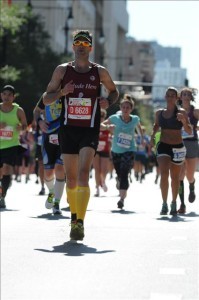 Pushing it – the only way out of a dark place.
Pushing it – the only way out of a dark place.I did my run/walk thing until mile 24, where I ran into another St. Jude Hero I had connected with on the way to the race who was walking. We ran a bit, then slowed it down to a walk as we reached the 25 mile marker. We looked at each other, and said, “Let’s do this!” We both ran the last mile before the final two tenths (together at first, but then our paces diverged as I pulled away, so we ran our own finish).
I saw the “800 M” sign, and picked it up a bit more, and started to pick off some runners in front of me. There were a few I spotted, but then thought they were moving too fast to catch – wrong! I was doing it. I was exhausted, but the idea of stopping now or walking again when I was so close had absolutely no effect on my body.
A sign read “400 M”.
I kept going, and got faster and faster. For anyone who doesn’t know the course, there is this ramp you run up and then make a left with a final sprint through the shoot to the finish. That ramp is steep relative to the rest of the course, which is basically flat. You’re so tired at that point that it feels like climbing a mountain. I tend to do well on hills, so I just pushed and heard everyone around me complaining about it, and some slowing to a walk.
“200 M” came along with a volunteer shouting, “Just make that turn at the flag, and then you’ll be right at the finish! Don’t stop now, you can do!” He was so right. His words really fueled my body so much. I saw people in front of me, and I picked them off with a solid push – arms pumping, euphoria and adrenaline doing their thing. I didn’t have much distance to pass them, but I did it. Again I saw people I wanted to pass, but didn’t think I could. My body ignored my mind again, and I took them.
I finished strong. In light of how the prior 10 miles went, I finished really strong. And I’m proud of that.
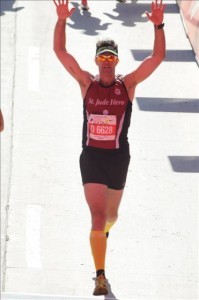 Coming through the finish line strong, proud and spent. I wouldn’t have it any other way.
Coming through the finish line strong, proud and spent. I wouldn’t have it any other way.My final time was 4:44:28. My Garmin recorded just over 27 miles covered, with the 26.2 distance of a marathon coming in 4:36 and a few seconds. Because of how tough the race was, how much I walked, and how my body felt, I was pretty down emotionally. I was so mentally drained that I was just in a stupor. I wanted to be happy about finishing, but I was so in the throws of discomfort that my disappointment was all I focused on.
I had a great, long lunch with my brother-in-law, who ran the race, too (he’s very experienced and much faster than I am), which was really helpful. Getting his perspective and support helped me through the day. I got a slightly longer night’s sleep (though still nowhere near what I need), and just had a lazy, movie-filled morning before making my way to the airport.
I talked to a lot of finishers in the airport (we were all on the same flight to Chicago, so we got to know each other, or at least recognize each other), and the overwhelming majority of folks I talked to did not have a good race. My time put me in the top 1/3 of finishers, which I wouldn’t have expected normally, so that helped with how I was feeling.
I wouldn’t be honest if I said I was just happy to have completed it, and feeling accomplishment for that without disappointment for how it went. But I am feeling better about it as time goes on, and actually writing this helped a lot. I don’t know if I’ll do another marathon – not because this turned me off from it, but more just because you never know what happens in life. I never thought I’d do one in the first place. I would like to do another one, so we’ll see what works out.
Here’s a video of me crossing the finish line. As the clock reads 4:56:24, watch me come down the right side pretty quickly (at least relative to others in the shot) as I raise my arms through the finish:
My biggest lesson from this race wasn’t about something I did or didn’t do because the majority of my performance falling short of what I wanted was out of my control from how I slept. I feel good about the work I put in with my training. No, instead my lesson is about how getting caught up in something can mean you miss the whole purpose of your experience. My being so let down with how it was going meant I didn’t really get to enjoy the race or value having finished.
I heard a podcast with the race direct of the Chicago Marathon, Carey Pinkowski, who gave some advice to first timers. He said, “Run your race.” It’s simple, and I didn’t value it when he said it. But it’s true. If you’re not an elite or paying the bills from how you raced, then don’t get caught up in anything. Run what you can run that day, try to enjoy what you’re doing and respect the amazing achievement. No matter how fast or slow you are, you are running a marathon. That’s huge. Most people don’t do this. Recognize and respect that.
So this piece has been cathartic for me, and I’m feeling the power of what I completed. It’s not about how I completed it, it’s about completing it. And I did it honestly with hard work before and during the event.
Allow yourself to be proud. Self-pride is a crucial component to enlighten.your.body.
Do a Day Blog
You can learn more about Do a Day and get links to all the ways you can get the book, coaching, or hire Bryan Falchuk as a speaker at http://www.doadaybook.com. ...more
- Bryan David Falchuk's profile
- 6 followers



